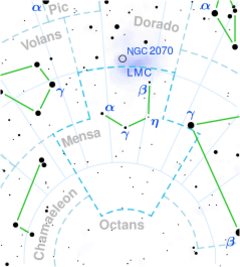Astronomy:Epsilon Mensae
| Observation data Epoch J2000.0 Equinox (celestial coordinates) | |
|---|---|
| Constellation | Mensa |
| Right ascension | 07h 25m 38.0987s[1] |
| Declination | −79° 05′ 39.0878″[1] |
| Apparent magnitude (V) | 5.52±0.01[2] |
| Characteristics | |
| Spectral type | K2/3 III[3] |
| U−B color index | +1.42[4] |
| B−V color index | +1.28[4] |
| Astrometry | |
| Radial velocity (Rv) | 10.5±2.9[5] km/s |
| Proper motion (μ) | RA: −29.197[1] mas/yr Dec.: +5.181[1] mas/yr |
| Parallax (π) | 7.1874 ± 0.0449[1] mas |
| Distance | 454 ± 3 ly (139.1 ± 0.9 pc) |
| Absolute magnitude (MV) | −0.24[6] |
| Details | |
| Mass | 1.15[7] M☉ |
| Radius | 21.94[8] R☉ |
| Luminosity | 170[9] L☉ |
| Surface gravity (log g) | 1.74[7] cgs |
| Temperature | 4,657±122[8] K |
| Metallicity [Fe/H] | −0.31[10] dex |
| Rotational velocity (v sin i) | 1.8±1.4[11] km/s |
| Age | 233[1] Myr |
| Other designations | |
| Database references | |
| SIMBAD | data |
Epsilon Mensae, Latinized to ε Mensae, is a single[14] star in the southern circumpolar constellation Mensa. It has an apparent magnitude of 5.52,[2] making it faintly visible to the naked eye under ideal conditions. The object has a heliocentric radial velocity of 10.5 km/s,[5] meaning it is receding from the Solar System, and is estimated to be 454 light years away.[1]
Epsilon Mensae has a stellar classification of K2/3 III — intermediate between a K2 and K3 giant star.[3] It has 115% the mass of the Sun[7] and an enlarged radius of 21.9 R☉. It shines at 170 times the luminosity of the Sun[9] from its photosphere at an effective temperature of 4,657 K,[8] giving it an orange glow. Epsilon Mensae has a metallicity 49% that of the Sun and is believed to be a member of the young disk population.[10] It spins leisurely with a projected rotational velocity of about 1.8 km/s.[11]
References
- ↑ 1.0 1.1 1.2 1.3 1.4 1.5 Vallenari, A. et al. (2022). "Gaia Data Release 3. Summary of the content and survey properties". Astronomy & Astrophysics. doi:10.1051/0004-6361/202243940 Gaia DR3 record for this source at VizieR.
- ↑ 2.0 2.1 Høg, E.; Fabricius, C.; Makarov, V. V.; Urban, S.; Corbin, T.; Wycoff, G.; Bastian, U.; Schwekendiek, P. et al. (March 2000). "The Tycho-2 catalogue of the 2.5 million brightest stars". Astronomy and Astrophysics 355: L27–L30. ISSN 0004-6361. Bibcode: 2000A&A...355L..27H.
- ↑ 3.0 3.1 Houk, N.; Cowley, A. P. (1975). University of Michigan Catalogue of two-dimensional spectral types for the HD stars. Volume I. Declinations -90_ to -53_ƒ0.. Bibcode: 1975mcts.book.....H.
- ↑ 4.0 4.1 Johnson, H. L.; Mitchell, R. I.; Iriarte, B.; Wisniewski, W. Z. (1966). "UBVRIJKL Photometry of the Bright Stars". Communications of the Lunar and Planetary Laboratory 4: 99–110. Bibcode: 1966CoLPL...4...99J.
- ↑ 5.0 5.1 Gontcharov, G. A. (November 2006). "Pulkovo Compilation of Radial Velocities for 35 495 Hipparcos stars in a common system". Astronomy Letters 32 (11): 759–771. doi:10.1134/S1063773706110065. ISSN 1063-7737. Bibcode: 2006AstL...32..759G.
- ↑ Anderson, E.; Francis, Ch. (May 2012). "XHIP: An extended hipparcos compilation" (in en). Astronomy Letters 38 (5): 331–346. doi:10.1134/S1063773712050015. ISSN 1063-7737. Bibcode: 2012AstL...38..331A.
- ↑ 7.0 7.1 7.2 Anders, F. et al. (August 2019). "Photo-astrometric distances, extinctions, and astrophysical parameters for Gaia DR2 stars brighter than G = 18". Astronomy & Astrophysics 628: A94. doi:10.1051/0004-6361/201935765. ISSN 0004-6361. Bibcode: 2019A&A...628A..94A.
- ↑ 8.0 8.1 8.2 Stassun, Keivan G. et al. (9 September 2019). "The Revised TESS Input Catalog and Candidate Target List". The Astronomical Journal 158 (4): 138. doi:10.3847/1538-3881/ab3467. ISSN 0004-6256. Bibcode: 2019AJ....158..138S.
- ↑ 9.0 9.1 McDonald, I.; Zijlstra, A. A.; Watson, R. A. (15 June 2017). "Fundamental parameters and infrared excesses of Tycho–Gaia stars". Monthly Notices of the Royal Astronomical Society 471 (1): 770–791. doi:10.1093/mnras/stx1433. ISSN 0035-8711. Bibcode: 2017MNRAS.471..770M.
- ↑ 10.0 10.1 Eggen, Olin J. (January 1989). "Large and Kinematically Unbiased Samples of G- and K-Type Stars. III. Evolved Young Disk Stars in the Bright Star Sample". Publications of the Astronomical Society of the Pacific 101: 54. doi:10.1086/132404. ISSN 0004-6280. Bibcode: 1989PASP..101...54E.
- ↑ 11.0 11.1 De Medeiros, J. R.; Alves, S.; Udry, S.; Andersen, J.; Nordström, B.; Mayor, M. (January 2014). "A catalog of rotational and radial velocities for evolved stars: V. Southern stars⋆⋆⋆". Astronomy & Astrophysics 561: A126. doi:10.1051/0004-6361/201220762. ISSN 0004-6361. Bibcode: 2014A&A...561A.126D.
- ↑ "eps Men". SIMBAD. Centre de données astronomiques de Strasbourg. http://simbad.u-strasbg.fr/simbad/sim-basic?Ident=eps+Men.
- ↑ Gould, Benjamin Apthorp (1878). "Uranometria Argentina : brillantez y posicion de las estrellas fijas, hasta la septima magnitud, comprendidas dentro de cien grados del polo austral : con atlas". Resultados del Observatorio Nacional Argentino 1. Bibcode: 1879RNAO....1.....G.
- ↑ Eggleton, P. P.; Tokovinin, A. A. (11 September 2008). "A catalogue of multiplicity among bright stellar systems". Monthly Notices of the Royal Astronomical Society 389 (2): 869–879. doi:10.1111/j.1365-2966.2008.13596.x. ISSN 0035-8711. Bibcode: 2008MNRAS.389..869E.
Coordinates: ![]() 07h 25m 38.0987s, −79° 05′ 39.0878″
07h 25m 38.0987s, −79° 05′ 39.0878″
 |


